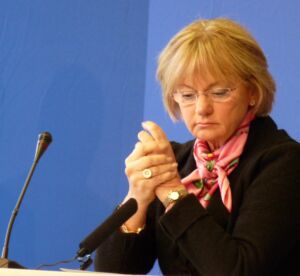Business & Education
How Mama Pia’s influence has spread beyond Danish shores
This article is more than 10 years old.
Pia Kjærsgaard’s impact extended far beyond the Danish borders that she fought so hard to keep closed

Her legacy is undeniable (photo: Brandsen)
In September 2012, Pia Kjærsgaard stood down as leader of the anti-immigration party Dansk Folkeparti (DF), which she has led since 1995. While the national media debated her impact on Denmark and politicians set aside their differences to praise her sheer determination, her departure also made waves abroad.
Wild about the girl
“Through Pia’s leadership and influence on Danish politics, Denmark has become a proud and self-assured country that has fought for the ideals of freedom against Islamisation and decrees from Brussels,” Dutch politician Geert Wilders told Ritzau. “Pia Kjærsgaard has been an inspiration for many of her political friends in other countries.”
Wilders is the leader of the Party for Freedom (PVV), an openly anti-Islamic party that has called for a complete end to immigration from non-Western countries. His open criticism of Islam and multiculturalism has made him an unpopular figure in the Netherlands and he requires 24-hour police protection due to the number of threats against his life.
PVV has proven popular with many Dutch voters, however, managing to become the Netherlands’ third largest party at the 2010 general elections, in which it secured 24 seats, before slipping back to 15 in 2012.
Like DF, but Dutch
Until it pulled its support and caused the collapse of the Dutch government in April 2012, it supported the minority government in much the same way DF did between 2001 and 2011. According to Sarah de Lange, an assistant professor at the Department of Political Science at the University of Amsterdam, this is no coincidence as the PVV emulated many of DF’s strategies to achieve political power.

“Geert Wilders admired DF’s ideology and organisation and he’s always made that clear,” De Lange told the Copenhagen Post.
“The ideology of welfare chauvinism [excluding immigrants from welfare benefits] was not originally one of their policies and only arrived later on as the party program developed. Then you started to see them defend the elderly and healthcare while also speaking up for the rights of natives over immigrants. These policies weren’t there in the beginning.”
De Lange argues that the PVV and DF have a fundamentally different approach to traditional right-wing parties that used to pursue corporatist and neoliberal agendas. In the move towards the left, the parties captured voters who were scared by how immigration could threaten the welfare state.
“The combination of welfare chauvinism and anti-immigration appeals to less-educated voters. But it’s also an economic program that better fits nationalism because neo-liberalism is about openness and free trade, whereas DF and the PVV are more inward-looking,” De Lange said.
No extreme connections
Susi Meret, an assistant professor at Aalborg University who is an expert in far-right groups, also agrees that DF was one of the first right-wing parties to link xenophobic social policies, anti-Muslim rhetoric, and promises of generous public spending. While this approach proved popular with voters, Meret also argues that the centralised control over the party message also contributed to DF’s success.
“DF have always been careful to show that they have no contact with extreme movements,” Meret told the Copenhagen Post.
“It was a strategy they implemented before joining the government because they had to have a profile in parliament that could be relied upon. Many people belonging to extreme movements were thrown out when their right-wing connections were made known.”
Wilders also recognised the need to keep a single strong message, according to De Lang.
“He saw it was important to have a tightly organised party, and if there were controversial members, they needed to be gotten rid of. Perhaps he even went further than DF because his party started out with only one member,” she said.
 Less success in Sweden
Less success in Sweden
The Swedish party Sverigedemokraterna also shares some policies with DF: anti-immigration, Euro-scepticism and the support of traditional family values. And while it has taken time to match the success of its Danish counterparts in national elections, it has started to break through in the last decade.
In Sweden’s 2010 general election it captured 5.7 percent of the vote, almost doubling the party’s previous result. And then in 2014, it grabbed 12.9 percent.
It is believed the party initially suffered due to an image problem resulting from its roots in the 1980s Swedish fascism movement. Anti-fascist organisation Expo revealed that 45 of Sverigedemokraterna’s candidates standing in the 2010 local elections had connections to far-right and white power movements.
While this may harm its image, the party has still made considerable headway since 1998 when it secured only 0.4 percent of the national vote. A boycott on printing advertisements for the Sverigedemokraterna was also lifted by two out of three major media publications in 2006.
Speaking to TV2 News after the announcement that Kjærsgaard would step aside at DF, Sverigedemokraterna leader Jimmie Åkesson explained how DF had operated as his party’s role model.
“Our respective parties have similar positions on many issues, and DF has often acted as a source of inspiration, not least because they are always a step ahead of the curve,” Åkesson told TV2 News. “We have often thought: ‘If DF can do it, we can do it.’”
This story was first published in September 2012.










































